FIAT STRADA 2012 Owner handbook (in English)
Manufacturer: FIAT, Model Year: 2012, Model line: STRADA, Model: FIAT STRADA 2012Pages: 187, PDF Size: 8.06 MB
Page 101 of 187
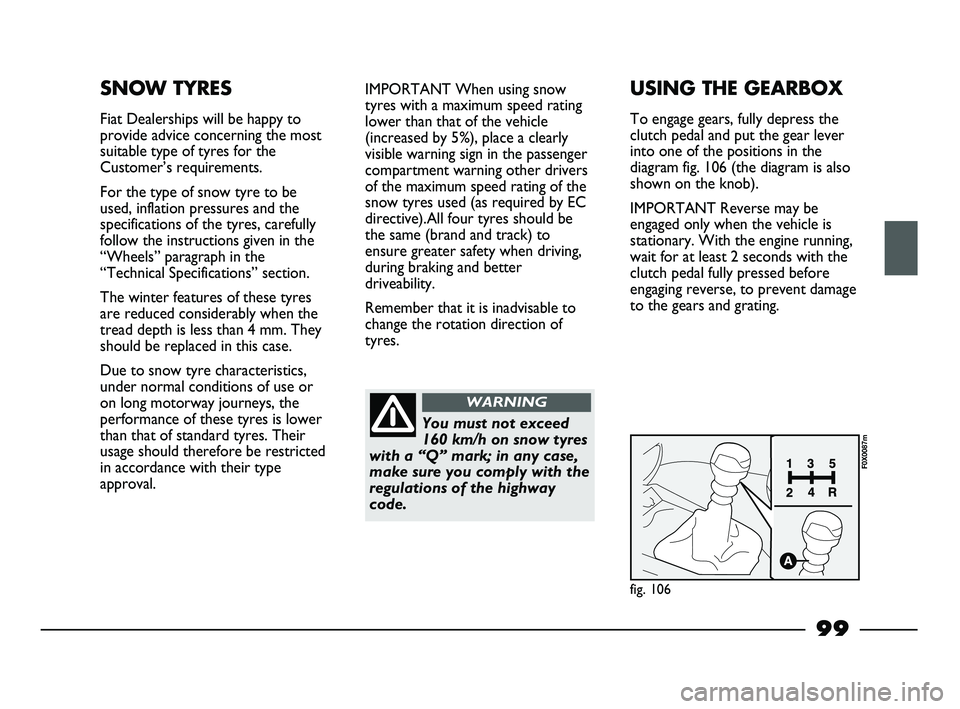
99
SNOW TYRES
Fiat Dealerships will be happy to
provide advice concerning the most
suitable type of tyres for the
Customer’s requirements.
For the type of snow tyre to be
used, inflation pressures and the
specifications of the tyres, carefully
follow the instructions given in the
“Wheels” paragraph in the
“Technical Specifications” section.
The winter features of these tyres
are reduced considerably when the
tread depth is less than 4 mm. They
should be replaced in this case.
Due to snow tyre characteristics,
under normal conditions of use or
on long motorway journeys, the
performance of these tyres is lower
than that of standard tyres. Their
usage should therefore be restricted
in accordance with their type
approval.IMPORTANT When using snow
tyres with a maximum speed rating
lower than that of the vehicle
(increased by 5%), place a clearly
visible warning sign in the passenger
compartment warning other drivers
of the maximum speed rating of the
snow tyres used (as required by EC
directive).All four tyres should be
the same (brand and track) to
ensure greater safety when driving,
during braking and better
driveability.
Remember that it is inadvisable to
change the rotation direction of
tyres.
USING THE GEARBOX
To engage gears, fully depress the
clutch pedal and put the gear lever
into one of the positions in the
diagram fig. 106 (the diagram is also
shown on the knob).
IMPORTANT Reverse may be
engaged only when the vehicle is
stationary. With the engine running,
wait for at least 2 seconds with the
clutch pedal fully pressed before
engaging reverse, to prevent damage
to the gears and grating.
You must not exceed
160 km/h on snow tyres
with a “Q” mark; in any case,
make sure you comply with the
regulations of the highway
code.
WARNING
fig. 106
F0X0087m
095-106 STRADA LUM GB 1ed 9-01-2012 14:51 Pagina 99
Page 102 of 187
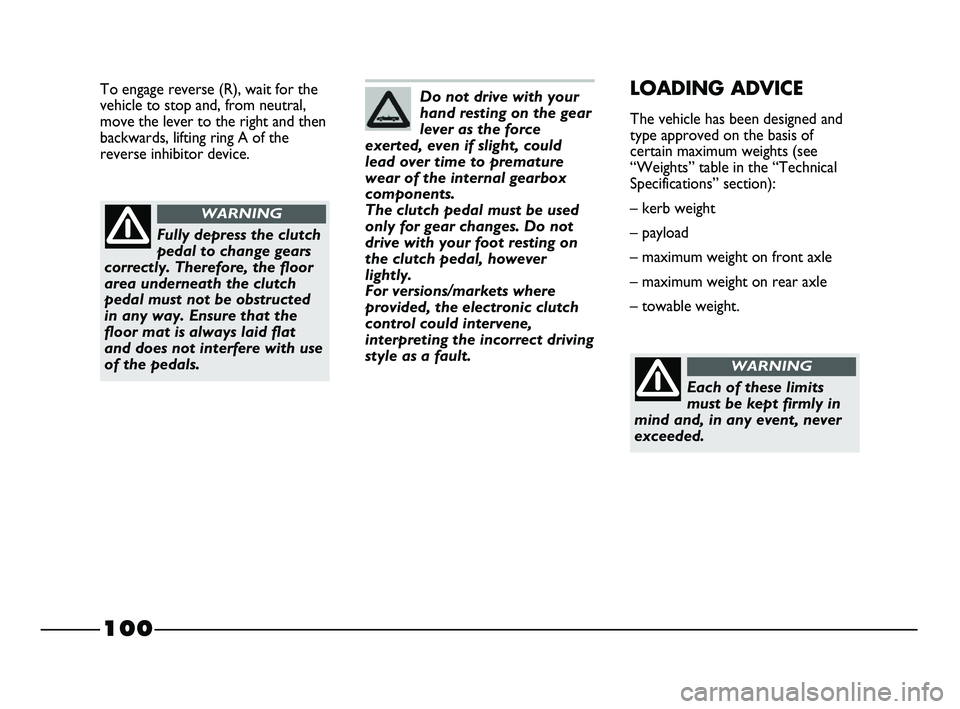
100
To engage reverse (R), wait for the
vehicle to stop and, from neutral,
move the lever to the right and then
backwards, lifting ring A of the
reverse inhibitor device.
Fully depress the clutch
pedal to change gears
correctly. Therefore, the floor
area underneath the clutch
pedal must not be obstructed
in any way. Ensure that the
floor mat is always laid flat
and does not interfere with use
of the pedals.
WARNING
Do not drive with your
hand resting on the gear
lever as the force
exerted, even if slight, could
lead over time to premature
wear of the internal gearbox
components.
The clutch pedal must be used
only for gear changes. Do not
drive with your foot resting on
the clutch pedal, however
lightly.
For versions/markets where
provided, the electronic clutch
control could intervene,
interpreting the incorrect driving
style as a fault.LOADING ADVICE
The vehicle has been designed and
type approved on the basis of
certain maximum weights (see
“Weights” table in the “Technical
Specifications” section):
– kerb weight
– payload
– maximum weight on front axle
– maximum weight on rear axle
– towable weight.
Each of these limits
must be kept firmly in
mind and, in any event, never
exceeded.
WARNING
095-106 STRADA LUM GB 1ed 9-01-2012 14:51 Pagina 100
Page 103 of 187
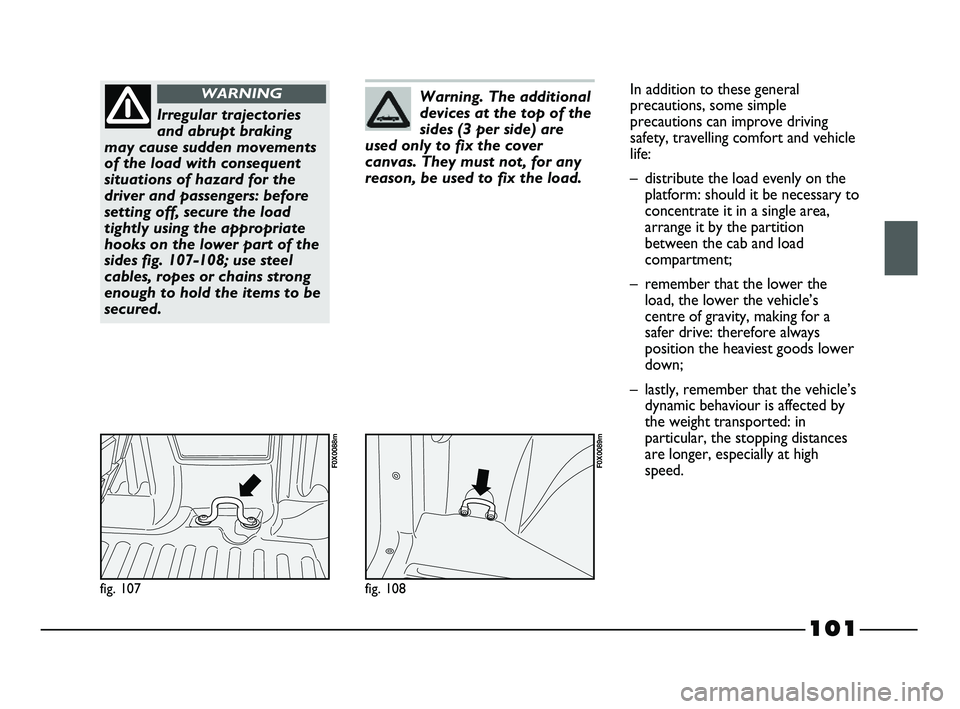
101
fig. 107
F0X0088m
Irregular trajectories
and abrupt braking
may cause sudden movements
of the load with consequent
situations of hazard for the
driver and passengers: before
setting off, secure the load
tightly using the appropriate
hooks on the lower part of the
sides fig. 107-108; use steel
cables, ropes or chains strong
enough to hold the items to be
secured.
WARNING
fig. 108
F0X0089m
Warning. The additional
devices at the top of the
sides (3 per side) are
used only to fix the cover
canvas. They must not, for any
reason, be used to fix the load.In addition to these general
precautions, some simple
precautions can improve driving
safety, travelling comfort and vehicle
life:
– distribute the load evenly on the
platform: should it be necessary to
concentrate it in a single area,
arrange it by the partition
between the cab and load
compartment;
– remember that the lower the
load, the lower the vehicle’s
centre of gravity, making for a
safer drive: therefore always
position the heaviest goods lower
down;
– lastly, remember that the vehicle’s
dynamic behaviour is affected by
the weight transported: in
particular, the stopping distances
are longer, especially at high
speed.
095-106 STRADA LUM GB 1ed 9-01-2012 14:51 Pagina 101
Page 104 of 187
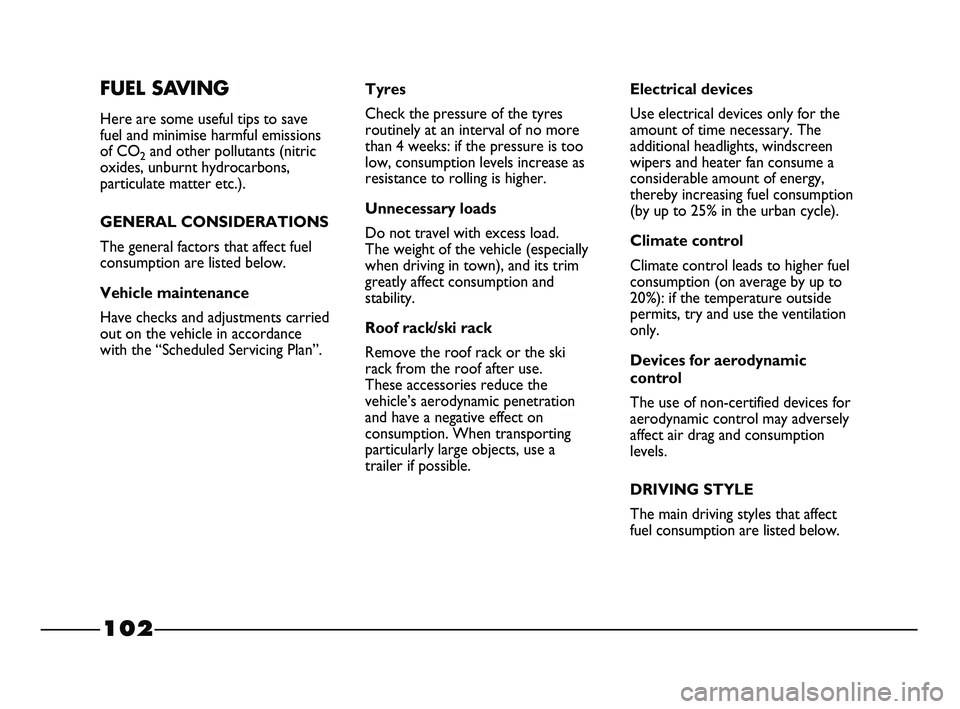
102
FUEL SAVING
Here are some useful tips to save
fuel and minimise harmful emissions
of CO
2and other pollutants (nitric
oxides, unburnt hydrocarbons,
particulate matter etc.).
GENERAL CONSIDERATIONS
The general factors that affect fuel
consumption are listed below.
Vehicle maintenance
Have checks and adjustments carried
out on the vehicle in accordance
with the “Scheduled Servicing Plan”.Tyres
Check the pressure of the tyres
routinely at an interval of no more
than 4 weeks: if the pressure is too
low, consumption levels increase as
resistance to rolling is higher.
Unnecessary loads
Do not travel with excess load.
The weight of the vehicle (especially
when driving in town), and its trim
greatly affect consumption and
stability.
Roof rack/ski rack
Remove the roof rack or the ski
rack from the roof after use.
These accessories reduce the
vehicle’s aerodynamic penetration
and have a negative effect on
consumption. When transporting
particularly large objects, use a
trailer if possible.Electrical devices
Use electrical devices only for the
amount of time necessary. The
additional headlights, windscreen
wipers and heater fan consume a
considerable amount of energy,
thereby increasing fuel consumption
(by up to 25% in the urban cycle).
Climate control
Climate control leads to higher fuel
consumption (on average by up to
20%): if the temperature outside
permits, try and use the ventilation
only.
Devices for aerodynamic
control
The use of non-certified devices for
aerodynamic control may adversely
affect air drag and consumption
levels.
DRIVING STYLE
The main driving styles that affect
fuel consumption are listed below.
095-106 STRADA LUM GB 1ed 9-01-2012 14:51 Pagina 102
Page 105 of 187
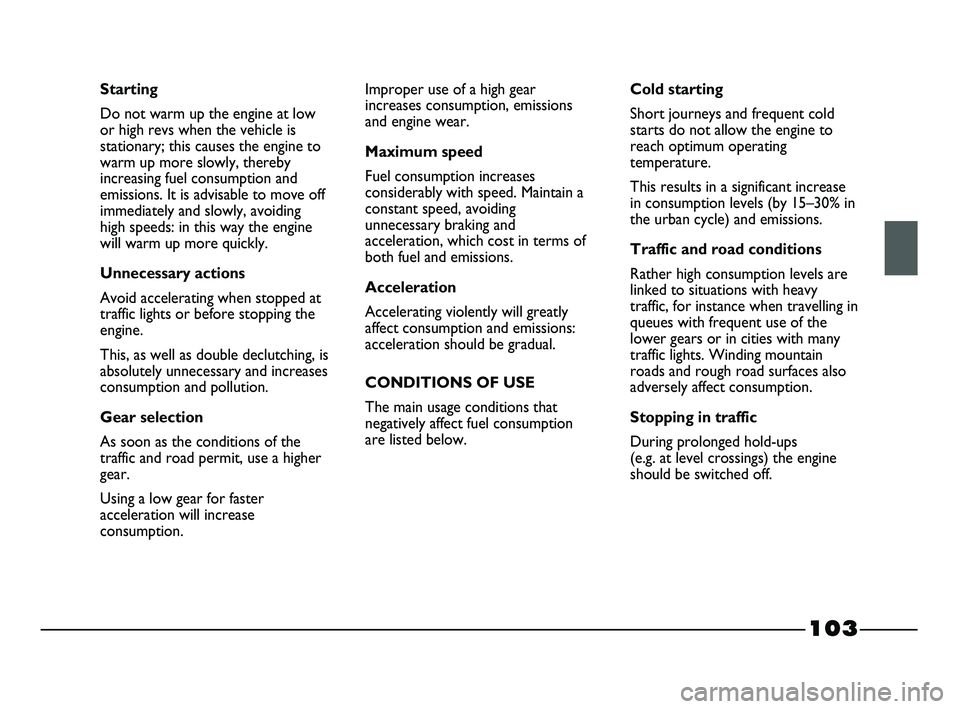
103
Starting
Do not warm up the engine at low
or high revs when the vehicle is
stationary; this causes the engine to
warm up more slowly, thereby
increasing fuel consumption and
emissions. It is advisable to move off
immediately and slowly, avoiding
high speeds: in this way the engine
will warm up more quickly.
Unnecessary actions
Avoid accelerating when stopped at
traffic lights or before stopping the
engine.
This, as well as double declutching, is
absolutely unnecessary and increases
consumption and pollution.
Gear selection
As soon as the conditions of the
traffic and road permit, use a higher
gear.
Using a low gear for faster
acceleration will increase
consumption.Improper use of a high gear
increases consumption, emissions
and engine wear.
Maximum speed
Fuel consumption increases
considerably with speed. Maintain a
constant speed, avoiding
unnecessary braking and
acceleration, which cost in terms of
both fuel and emissions.
Acceleration
Accelerating violently will greatly
affect consumption and emissions:
acceleration should be gradual.
CONDITIONS OF USE
The main usage conditions that
negatively affect fuel consumption
are listed below.Cold starting
Short journeys and frequent cold
starts do not allow the engine to
reach optimum operating
temperature.
This results in a significant increase
in consumption levels (by 15–30% in
the urban cycle) and emissions.
Traffic and road conditions
Rather high consumption levels are
linked to situations with heavy
traffic, for instance when travelling in
queues with frequent use of the
lower gears or in cities with many
traffic lights. Winding mountain
roads and rough road surfaces also
adversely affect consumption.
Stopping in traffic
During prolonged hold-ups
(e.g. at level crossings) the engine
should be switched off.
095-106 STRADA LUM GB 1ed 9-01-2012 14:51 Pagina 103
Page 106 of 187
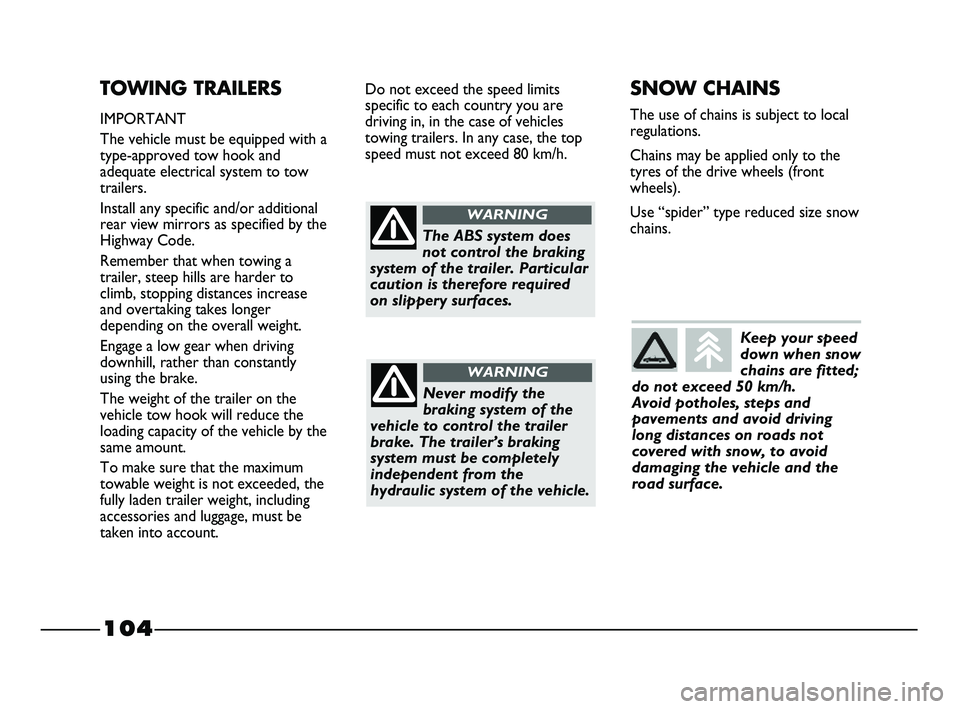
104
TOWING TRAILERS
IMPORTANT
The vehicle must be equipped with a
type-approved tow hook and
adequate electrical system to tow
trailers.
Install any specific and/or additional
rear view mirrors as specified by the
Highway Code.
Remember that when towing a
trailer, steep hills are harder to
climb, stopping distances increase
and overtaking takes longer
depending on the overall weight.
Engage a low gear when driving
downhill, rather than constantly
using the brake.
The weight of the trailer on the
vehicle tow hook will reduce the
loading capacity of the vehicle by the
same amount.
To make sure that the maximum
towable weight is not exceeded, the
fully laden trailer weight, including
accessories and luggage, must be
taken into account.Do not exceed the speed limits
specific to each country you are
driving in, in the case of vehicles
towing trailers. In any case, the top
speed must not exceed 80 km/h.
The ABS system does
not control the braking
system of the trailer. Particular
caution is therefore required
on slippery surfaces.
WARNING
Never modify the
braking system of the
vehicle to control the trailer
brake. The trailer’s braking
system must be completely
independent from the
hydraulic system of the vehicle.
WARNING
SNOW CHAINS
The use of chains is subject to local
regulations.
Chains may be applied only to the
tyres of the drive wheels (front
wheels).
Use “spider” type reduced size snow
chains.
Keep your speed
down when snow
chains are fitted;
do not exceed 50 km/h.
Avoid potholes, steps and
pavements and avoid driving
long distances on roads not
covered with snow, to avoid
damaging the vehicle and the
road surface.
095-106 STRADA LUM GB 1ed 9-01-2012 14:51 Pagina 104
Page 107 of 187

105
LONG VEHICLE
INACTIVITY
If the vehicle needs to be off the
road for longer than a month, the
following precautions should be
taken:
– Park the vehicle indoors in a dry
and, if possible, well-ventilated
place.
– Engage a gear.
– Check that the handbrake is not
engaged.
– Disconnect the negative battery
terminal and check the state of
charge (see “Battery” in the
“Vehicle maintenance” section).
– Clean and protect the painted
parts using protective waxes.– Clean and protect the shiny metal
parts using specific commercially
available compounds.
– Sprinkle talcum powder on the
rubber windscreen wiper blades
and lift them off the glass.
– Slightly open the windows.
– Cover the vehicle with a piece of
fabric or perforated plastic sheet.
Do not use compact plastic
tarpaulins, which prevent humidity
from evaporating from the surface
of the vehicle.– Inflate tyres to +0.5 bar above the
standard prescribed pressure and
check it at intervals.
– Do not drain the engine cooling
system.
095-106 STRADA LUM GB 1ed 9-01-2012 14:51 Pagina 105
Page 108 of 187

page intentionally left blank
095-106 STRADA LUM GB 1ed 9-01-2012 14:51 Pagina 106
Page 109 of 187
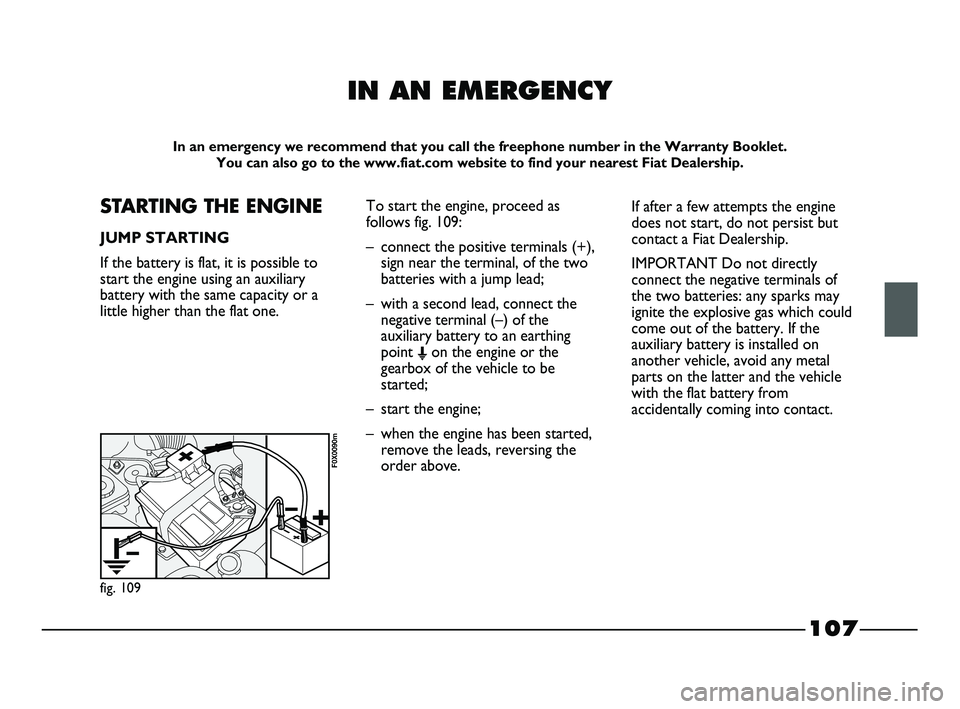
107
IN AN EMERGENCY
In an emergency we recommend that you call the freephone number in the Warranty Booklet.
You can also go to the www.fiat.com website to find your nearest Fiat Dealership.
STARTING THE ENGINE
JUMP STARTING
If the battery is flat, it is possible to
start the engine using an auxiliary
battery with the same capacity or a
little higher than the flat one.
fig. 109
F0X0090m
To start the engine, proceed as
follows fig. 109:
– connect the positive terminals (+),
sign near the terminal, of the two
batteries with a jump lead;
– with a second lead, connect the
negative terminal (–) of the
auxiliary battery to an earthing
point
Eon the engine or the
gearbox of the vehicle to be
started;
– start the engine;
– when the engine has been started,
remove the leads, reversing the
order above.If after a few attempts the engine
does not start, do not persist but
contact a Fiat Dealership.
IMPORTANT Do not directly
connect the negative terminals of
the two batteries: any sparks may
ignite the explosive gas which could
come out of the battery. If the
auxiliary battery is installed on
another vehicle, avoid any metal
parts on the latter and the vehicle
with the flat battery from
accidentally coming into contact.
107-132 STRADA LUM GB 1ed 9-01-2012 14:52 Pagina 107
Page 110 of 187

108
BUMP STARTING
Never bump start the engine by
pushing, towing or driving downhill.
This could cause fuel to flow into
the catalytic converter and damage it
beyond repair.
IMPORTANT The brake servo and
power steering are not operational
until the engine has been started, so
you need to apply much more force
than usual to the brake pedal and
steering wheel.IF A TYRE IS
PUNCTURED
General instructions
To use the jack and
space-saver wheel
correctly, some
precautions are necessary,
described below.
Never use a quick
battery charger to start
the engine as this could
damage the electronic systems,
particularly the ignition and fuel
supply control units.
Incorrect positioning of
the jack may cause the
raised vehicle to fall. Do not
use the jack for loads greater
than that indicated on the jack
itself. The jack is only to be
used for replacing wheels on
the vehicle with which it is
provided. Never use the jack
for other purposes, such as
lifting other vehicles. Never use
the jack to carry out repairs
under the vehicle. Do not
grease the threads of bolts
before fitting them: they might
slip out.
WARNING
This procedure must be
performed by expert
personnel as incorrect actions
may cause high-intensity
electrical discharge.
Furthermore, battery fluid is
poisonous and corrosive: avoid
contact with skin and eyes.
Keep naked flames and lit
cigarettes away from the
battery. Do not create sparks.
WARNING
107-132 STRADA LUM GB 1ed 9-01-2012 14:52 Pagina 108